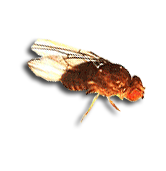Vinegar or 'Fruit' Fly
|
General Characteristics: - The common fruit fly is normally a yellow brown (tan) color, and is only about 3 mm in length and 2 mm in width Reproduction: - Larvae live in a variety of fruit, seeds (often Asteraceae), are leaf miners, or cause galls - A single pair of flies can produce hundreds of offspring within a couple of weeks, and the offspring become sexually mature within one week - The eggs are placed on fruit, and hatch into fly larvae (maggots), which instantly start consuming the fruit on which they were laid - They are easily drawn towards the smell of any food source, and will mate almost indiscriminately with any individual of the opposite sex. Signs of Infestation: - Lives primarily on plant material - Eggs are usually laid on unripened/slightly ripened fruit, so by the time the larva develop the fruit will have just started to rot, and they can use the fruit that the egg was laid on as their primary source of nutrition. Control Techniques: - Close and seal as many openings as possible through which the flies can enter. This procedure is time consuming and may require a dedicated long term effort. Miller, C. 2000. "Drosophila melanogaster" (On-line), Animal Diversity Web. Accessed January 11, 2010 at http://animaldiversity.ummz.umich.edu/site/accounts/information/Drosophila_melanogaster.html. “Family Tephritidae - Fruit Fly” (On-line). Iowa State University Entomology. Accessed Jan.
|


